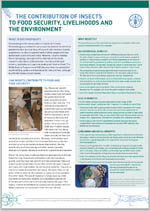energy are foreseen.

The Contribution of Insects to Food Security, Livelihoods and the Environment
Edible insects contain high quality protein, vitamins and amino acids for humans. Insects have a high food conversion rate, e.g. crickets need six times less feed than cattle, four times less than sheep, and twice less than pigs and broiler chickens to produce the same amount of protein. Besides, they emit less greenhouse gases and ammonia than conventional livestock. Insects can be grown on organic waste. Therefore, insects are a potential source for conventional production (mini-livestock) of protein, either for direct human consumption, or indirectly in recomposed foods (with extracted protein from insects); and as a protein source into feedstock mixtures.
Since 2003, FAO has been working on topics pertaining to edible insects in many countries worldwide. FAO’s contributions cover the following thematic areas: the generation and sharing of knowledge through publications, expert meetings and a web portal on edible insects;
awareness-raising on the role of insects through media collaboration (e.g. newspapers, magazines and TV);
the provision of support to member countries through field projects (e.g. the Laos Technical Cooperation Project);
networking and multidisciplinary interactions (e.g. stakeholders working with nutrition, feed and legislation-related issues) with various sectors within and outside FAO .
No comments:
Post a Comment